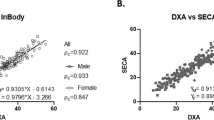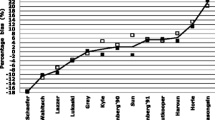Abstract
Background
Body mass index (BMI) is the most common parameter for classifying nutritional status. However, body composition (BC) may vary considerably among individuals with identical BMIs; consequently, we need to assess BC efficiently. Bariatric surgery is the most effective method for treating obesity. To improve quality assessment of postoperative weight loss, it is essential to assess BC. Multi-frequency bioelectrical impedance analysis (BIA) is a practical assessment instrument, though limited when applied among the obese population. Despite dual-energy X-ray absorptiometry (DXA) being the current reference standard, it has physical limitations which restrict its practical application. This study, therefore, sought to correlate the results of BC assessments of same patient population using BIA and DXA.
Methods
This was a cross-sectional validation study with patients invited to undergo a multi-frequency BIA (Inbody 720®) and afterwards a DXA examination Statistical analyses were done using the intraclass correlation coefficient (ICC), paired t-test and the Bland–Altman plot analysis.
Results
A total of 108 patients were randomly selected, with 73 meeting the criteria for study inclusion. Most were female (89 %) and had an average BMI of 40.17 ± 4.08 kg/m2. An almost perfect correlation of fat (kg) and fat-free mass (kg) was found in results from the BIA and DXA examination (ICC = 0.832 and ICC = 0.899, respectively). A substantial correlation was also found between the percentage of body fat (%BF) and the percentage of fat-free mass (%FFM). The comparison made between the BIA and DXA using the t-test showed significant differences between all parameters. The Bland–Altman plot showed that the BIA method tends to underestimate the FM and overestimate the LM measurements when compared with DXA.
Conclusion
BIA proved to be a safe alternative for assessing BC in clinically severely obese patients and thus provides a more accessible evaluation tool for this population. But, consideration should be given to the formula added to the BIA measurement, adjusting the values to differences observed in order to reduce errors when compared with the DXA measurements.




Similar content being viewed by others
References
Wandell PE, Carlsson AC, Theobald H. The association between BMI value and long-term mortality. Int J Obes (Lond). 2009;33(5):577–82.
World Health Organization (WHO). http://www.who.int/en/. Accessed July 2010.
Must A, Spadano J, Coakley EH, et al. The disease burden associated with overweight and obesity. Am J Med Assoc. 1999;282:1523–9.
Donini LM, Poggiogalle E, Del Balzo V, et al. How to estimate fat mass in overweight and obese subjects. Int J Endocrinol. 2013;2013:285680.
Das SK. Body composition measurement in severe obesity. Curr Opin Clin Nutr Metab Care. 2005;8(6):602–6.
Valezi AC, Junior JM, de Menezes MA. Weight loss outcome after silastic ring Roux-en-Y gastric bypass: 8 years of follow-up. Obes Surg. 2010;20:1491–5.
Kyle UG, Bosaeus I, De Lorenzo AD, et al. Bioelectrical impedance analysis—Part II. Utilization in clinical practice. Clin Nutr. 2004;23(6):1430–53.
Bracco D, Thiebaud D, Chiolero R, et al. Segmental body composition assessed by bioelectrical impedance analysis and DEXA in humans. J Appl Physiol. 1996;81:2580–7.
Szklo M, Nieto, JF. Epidemiology beyond the basics. 2000; 377.
Kehayias JJ, Heymsfield SB, Dilmanian FA, et al. Measurement of body fat by neutron inelastic scattering: comments on installation, operation and error analysis. Basic Life Sci. 1990;55:339–46.
Hendel HW, Gotfredsen A, Hojgaard L, et al. Change in fat-free mass assessed by bioelectrical impedance, total body potassium and dual energy X-ray absorptiometry during prolonged weight loss. Scand J Clin Lab Invest. 1996;56(8):671–9.
Strain GW, Wang J, Gagner M, et al. bioelectral impedance for severe obesity: comparing research methods for total body water and resting energy expenditure. Obesity (Silver Spring). 2008;16(8):1953–6.
Heyward VH, Wagner DR. Applied body composition assessment. Champaign: Human Kinetics Pub Incorporated; 2004. 268 p.
Pietrobelli A, Wang Z, Formica C, et al. Dual-energy X-ray absorptiometry: fat estimation errors due to variation in soft tissue hydratation. Am J Physiol. 1998;274:808–16.
Tg L. Harris M, Teixeira P J, et al. Assessing body composition and changes in body composition: another look at dual-energy X-ray absorptiometry. Ann N Y Acad Sci. 2000;904:45–54.
Acknowledgments
This study received financial support from Gastrocirurgia, Brasília, Brazil. SEPS 710/910, Centro Clínico Via Brasil, Salas 314, 334, 336, 337, 348, 70390-108 Brasília, Brazil.
Conflict of interest
All the authors declare that they have no conflict of interest.
Author information
Authors and Affiliations
Corresponding author
Rights and permissions
About this article
Cite this article
Faria, S.L., Faria, O.P., Cardeal, M.D.A. et al. Validation Study of Multi-Frequency Bioelectrical Impedance with Dual-Energy X-ray Absorptiometry Among Obese Patients. OBES SURG 24, 1476–1480 (2014). https://doi.org/10.1007/s11695-014-1190-5
Published:
Issue Date:
DOI: https://doi.org/10.1007/s11695-014-1190-5




